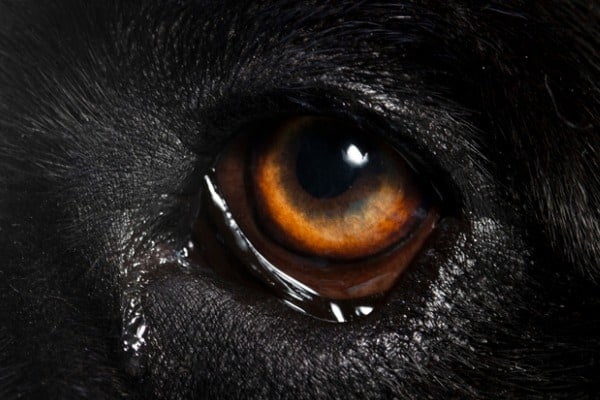
Here’s a scenario most pet parents are familiar with:
Your fur baby lovingly rubs their head against you.
You enjoy the affection, only to realize they were using you as a tissue.
Now, you have some lovely dog eye goop on yourself.
Thanks, Fido.
Don’t get too upset with your dog for this etiquette blunder.
After all, they don’t exactly understand the subtle nuances of human social norms.
There’s not a whole lot you can do to stop your dog from trying to wipe eye boogers on you – or furniture, the baby, etc.
However:
You can take a few measures to minimize the gunk that builds up in their eyes.
Work on lessening the eye goop, and you’ll find that your dog is less inclined to wipe their face in inappropriate places.
We’ll cover the basics of dog eye gunk removal, and when it’s an issue to talk to the vet about.
A Word on Conjunctivitis
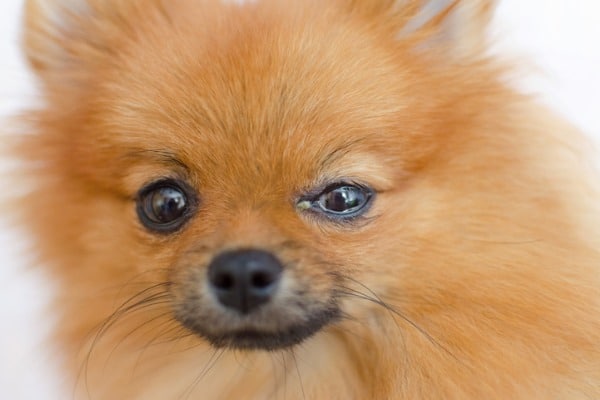
The eye gunk we’re referring to in this article is the typical, normal eye goop that can happen to any dog.
It frequently does goo up the eyes of dogs of all ages.
Normal eye boogers are greyish, sometimes dark or tan in color, and tend to ball up in the inner corners of the eye or on the lower rim of the eyelid.
They can be big and frequent – and gross – without being a real issue.
The problem is:
If your dog’s eye discharge is runny and has a yellow, green, or brown tinge to it.
Blood present in the discharge is also a sign of an infection or eye injury.
This type of discharge might also have a distinct or even foul odor, which you may smell on your dog’s face.
That’s not a great sign.
Runny eyes that weep for long periods and have unusual discharge are infected, irritated, or injured eyes.
While you can wipe up this discharge at home, it should only be a temporary solution until the vet can evaluate your dog’s condition.
Leave the treatment for this dog health issue to the vet – your dog could need prescription eye drops or antibiotics.
Avoid rubbing your dog’s eyes as you clean up the discharge, and be gentle.
A damp towel or washcloth is the best way to handle cleanup until your dog’s vet appointment.
Dog Eye Gunk Removal
Eye boogers are something people deal with on a regular basis.
In both dogs and humans, they’re a sign of healthy, functioning eyes.
When debris enters the eye, the tears that are normally produced combine with the debris – along with skin cells and mucus.
The resulting gunk is known as rheum, the scientific term for eye goop.
You might notice your dog has more eye boogers in the morning or after a long nap – sometimes, it can appear as a crust around their eyes.
Sound familiar?
Rheum has more chance to build-up to a noticeable amount when your dog’s eyes have been closed for an extended period.
Though, eye boogers aren’t only present after sleep.
Normal eye boogers should not require any special wash to remove.
They should wipe out easy from your dog’s eyes.
If your dog’s eyes have crusty build-up, it can take a little more to get them totally clean, but don’t put your pup in the bath just yet.
How to Clean Dog Eye Boogers
Normal eye boogers are soft and shouldn’t be sticking in your dog’s eyes.
Eye goop that has migrated to the inner corner of your dog’s eyes can be removed safely as long as you use a gentle hand.
1. The Washcloth Method
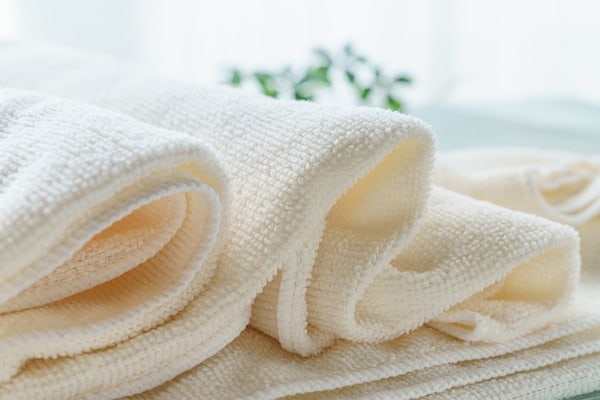
If you find yourself removing your dog’s eye boogers often, you may want to designate a washcloth just for this purpose. Make sure it’s nice and soft, though.
Why?
Anything too rough to touch your own face is too rough for your dog.
Dampen it with warm water, but not too hot. Make sure it’s not too hot to hold in your hand – it’s going near your dog’s eyes, after all.
Most dogs are cooperative enough for a quick eye wipe, especially if it’s part of the routine.
Still…
If your dog is less than thrilled about this part of their hygiene routine, you or someone else can hold their head steady so they don’t pull away.
Wiping the boogers out of their eyes should take less than ten seconds, so even if they start to protest, it’ll all be over by the time they give you too much grief.
Gently wipe over the corners of their eyes, applying just enough pressure to pull the eye boogers loose with the cloth.
You might end up wiping them onto your dog’s face, as eye boogers on the dry side don’t always stick to the damp cloth.
If you’ve dragged the boogers onto your dog’s face, simply whisk them up with the cloth or tissue.
This method can work if the eye booger has started to harden into “eye sand”.
If the eye booger has solidified significantly, hold the damp rag over their eye for thirty seconds or so.
Want to know a pro tip?
A good distraction, such as a snack or a good ear scratching, raises the chances that your dog will take it in a calm manner.
The heat and moisture will help soften eye sand, making it easier and more comfortable to remove.
2. Q-tips and Tissues
We recommend this only if your dog is patient and doesn’t wiggle or flinch when you clean their eyes, so there is little risk of poking them.
A swift swipe of a q-tip or even a tissue, in a pinch, can remove the boogers from their eyes.
Be sure not to “dig” too deep into the corner of their eye to get the booger out.
If you fail to work it loose after a few passes, try the warm washcloth method instead.
A small word of caution on using tissues and q-tips – avoid the cheap kind.
Why does that matter?
Cheaper q-tips can shed material, and cheaper tissues can leave lint behind.
Neither one of these things would be great to leave in your dog’s eye.
Hello, more eye boogers.
For similar reasons, you should avoid or at least be very cautious using things such as cotton balls, cotton pads, and toilet paper to remove eye boogers.
3. Avoid the Surface of the Eye
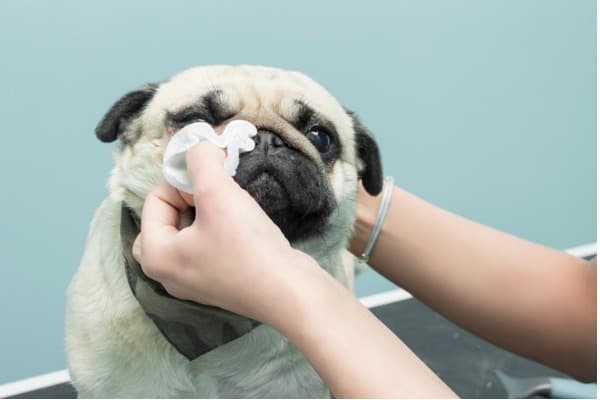
These methods are for removing eye boogers that are hanging out in the corners or edges of your dog’s eyes.
Keep in mind, though;
If you see a mucus-like substance or eye gunk floating around over their pupil and iris, it’s best to wait for it to migrate to the edges of the eye.
Eye goop can sometimes take a while to settle somewhere that it’s easy to remove.
As long as it’s not an unusual amount that is obviously obstructing your dog’s vision, there’s no problem in letting it work its way to the rim and corners of the eyes on its own.
4. Don’t Use Wet Wipes
It might seem helpful, but a wet wipe is not ideal for removing gunk from your dog’s eyes.
The issue lies in the harsh detergents and substances in wet wipes – many contain alcohol and other eye irritants that would do more harm than good.
If you wouldn’t put it near your own eye, then it’s safe to assume your dog’s eyes should be extended the same courtesy.
The one exception to this rule are dog eye wipes.
They’re made specifically for wiping eyes, are gentle, and safe in case you accidentally make contact with your dog’s eye with the wipe.
These wipes are handy to carry for wiping eye boogers on the go and can be found most places pet supplies are sold.
How to Clean Dog Eye Crust
For typical eye goop, a dog eye cleaner isn’t necessary.
However, for tear stains and crusty eyes, a cleaner can help make the task easier.
1. Use Cleaner Only on the Exterior of the Eye
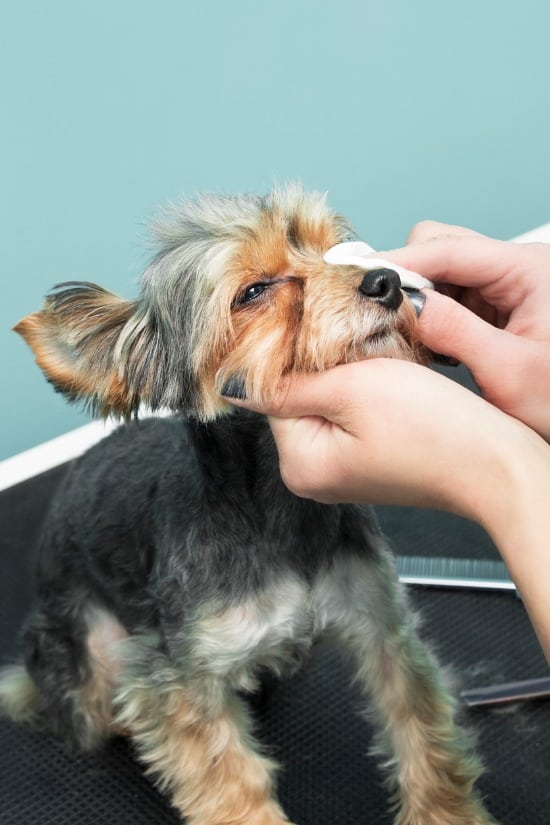
Tear stain remover can help remove crust by softening it and loosening it.
Gentle, pH balanced formulas are the safest to use around your dog’s eyes.
Make sure you only use this on eye crust that is outside of the eyes and avoid too much contact with any skin tags your dog may have on its eyelids.
Most tear cleaners recommend you douse a cotton pad with the liquid and apply it to the stained areas.
If you’re using tear stain remover to get rid of eye crust, simply wet the crusty areas and wipe with a damp rag.
2. Back to the Washcloth Method
Don’t have any tear stain remover?
The warm washcloth method listed above will help loosen up eye crust.
It can take several wipes to get rid of stubborn eye crust.
If your dog has long or thick hair on their face – such as a Shih Tzu – you might find this task takes some time.
3. Sometimes a Bath Is Necessary
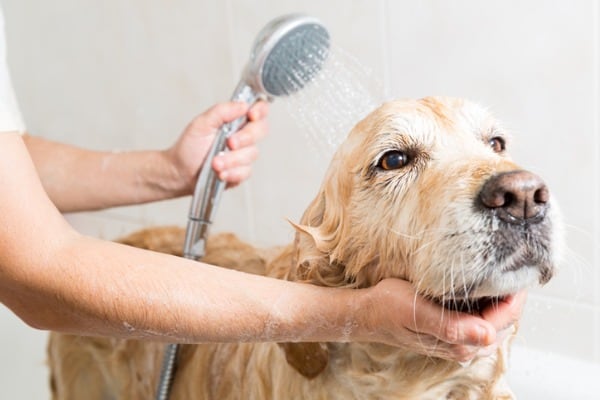
In the long run,
For heavy crust build-up under the eyes, going straight for a wash-up or a full bath can be the easier route.
When using shampoo around a dog’s eyes:
Be careful not to let any run into their eyes.
Make sure your dog isn’t able to struggle so much they get soap in their eyes.
Always use pet-safe shampoo.
For face washing purposes, extra-gentle shampoos made for the face are available at most pet product stores.
Cleaning Tear Stains
Have you ever noticed this?
In some dogs, tear stains may make it look like your dog’s eyes have black gunk coming from them.
The tears that are coming from your dog’s eyes aren’t black, but they can turn into black or dark brown or reddish stains on your dog’s face.
You can thank a chemical called porphyrin for those stains. Luckily, it’s quite common in many breeds, and can be solved with a tear stain remover.
Is Prevention Possible?
In the case of typical eye gunk – or rheum – it’s not preventable.
Here’s the thing, though:
You don’t want your dog to stop producing eye boogers, as they help keep their eyes free of dust and debris.
In some cases, your dog’s eye boogers might seem excessive.
More times than not, this is because they are exposed to more debris, and their bodies are working double-time to keep their eyes clean and healthy.
For example:
A working dog who spends a lot of time in a barn or paddocks is exposed to more dust than the typical dog.
As such, they might have a higher amount of eye boogers than a house pet.
It may be possible to reduce the volume of your dog’s eye gunk by limiting their exposure to such debris.
If you have a dusty environment, extra vacuuming can help reduce the amount of time you spend cleaning eye goop from your dog’s eyes.
Allergens are another culprit for the cause of eye gunk and discharge.
Allergies can even cause your dog’s paw pad to peel!
It’s not always possible to protect your dog from things like pollen and environmental pollutants.
Nevertheless,
If you’re seriously invested in scaling back the allergens your dog is exposed to, an air filter is a simple solution.
In the meantime,
How about protecting your clothes from being used as a tissue for eye boogers?
It’s possible to teach a dog not to wipe their face on you or the furniture.
Punishing them for it won’t do much good, but you can redirect them and stop them in the act.
If you’ve had your dog wipe their eyes on you before, you probably can tell when they’re about to do it.
The best thing you can do is get away from them before they have a chance to leave eye goo behind and get the eye gunk out yourself right away.
What about excess tears?
Several breeds are prone to overproducing the tears, which lead to staining.
Short-nosed breeds are at the highest risk for this condition, which isn’t serious but can be inconvenient.
If excessive tearing is due to breed and genetics, there isn’t much you can do but manage the side-effects, such as that black staining on your dog’s face.
Regardless of your dog’s breed, it is always a good idea to get weepy eyes checked out by a vet to make sure it’s not blocked tear ducts or other conditions that require further treatment.
Dog Eye Gunk – Icky But Normal
As a pet parent, you’ve most likely already dealt with cleaning up poop, pee, and puke.
What’s a little eye gunk after eight weeks of potty training?
We’ve all been there.
It’s not an appealing task, but cleaning your dog’s eyes can help avoid their eye goop being left on your couch – or jeans.
So, what should be your key lesson on how to clean your dog’s eyes?
A gentle touch is the most important thing.
A patient dog helps, but even squirmy pups should get used to the routine after a while.
